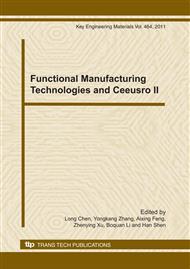p.167
p.171
p.175
p.179
p.183
p.187
p.191
p.195
p.199
Stability Analysis and Improvement of Virtual Wall Model
Abstract:
Sampled-data system’s nature is the main factor that causes virtual wall to demonstrate active (non-passive) behavior, destroying the illusion of reality. To enhance the stability of haptic rendering by virtual wall model, a novel spring-impulse model based on energy conversation and momentum conversation is proposed. In the model, an impulse in the opposite direction of avatar’s velocity is exerted on avatar at the instant from inner of virtual wall back to balance position during unstable state. This resistant forces eliminate extra work to reduce the non-passive behaviors of the haptic system, which lead to improved realistic rigid perceptions and system stability. The experiments have verified the effectiveness of our spring-impulse method in a virtual stiff-wall prototype system via a Phantom Omni haptic device.
Info:
Periodical:
Pages:
183-186
Citation:
Online since:
January 2011
Authors:
Keywords:
Price:
Сopyright:
© 2011 Trans Tech Publications Ltd. All Rights Reserved
Share:
Citation:


